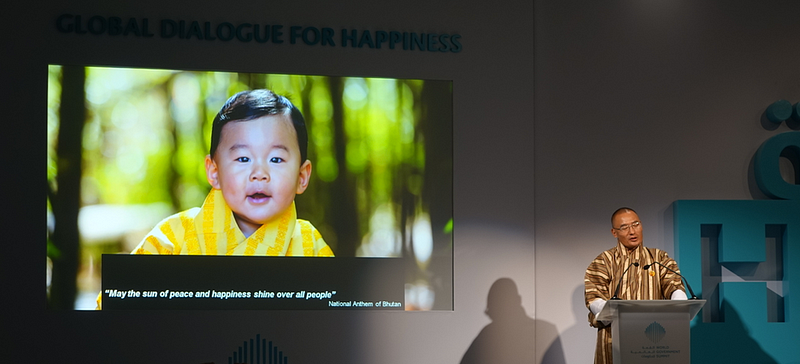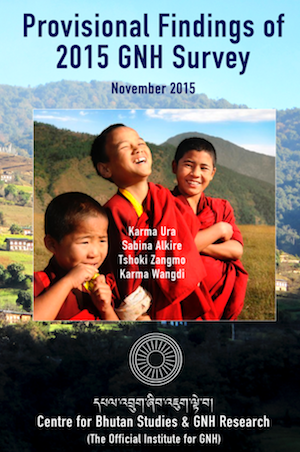A giant blue balloon with a winking smiley face is tethered 40 feet off the ground. It really looks like if you caught the strings, you could fly away like Curious George. It’s February 11th, in Dubai, and the World Government Summit is being kicked off with a pre-meeting held by the Minister of Happiness. The topic is Dialogue for Global Happiness.
Someone says this could be the most important meeting in the world. It may be. The speakers include Bhutan’s Prime Minister Tobgay. His country has the longest track record of measuring and managing happiness for the purpose of government. They call it Gross National Happiness.
Tobgay is Bhutan’s second Prime Minister (the country only recently became a democratic monarchy). When he was first elected, rumor had it he was giving up on Gross National Happiness. Not so.
“The simple fact is that governments are not taking the happiness of people seriously enough” Prime Minister Tobgay beings.
Bhutan’s foundation for governing for happiness was lain 400 years ago, when the Nation’s founding father decreed that if government cannot create happiness for the people, there is no purpose for government to exist. Today happiness policies include green, clean, socially and responsible economic development. Free education and healthcare. Bhutan is a carbon negative country, with over 72% of the land covered in forest, and 60% of the land constitutionally protected in forest cover. Tobgay claims Bhutan is the only country that did not have to fight to become a democracy. The last king took such an interest in his people’s happiness that he decided good governance (an aspect or “domain” of happiness) predicated the country become democratic.
In Bhutan, the government measures Gross National Happiness through 9 domains. There are the time-honored ones of the economy, governance, environment, society and health. But they also use cutting edge domains: time balance, community vitality, culture and psychological well-being. These domains define the conditions of happiness.
In 2015 they conducted a third survey (this one took 1.5 hours to complete, the prior one, conducted in 2010, took 4 hours) and found that some people had improved in some areas, fallen in others. Women’s happiness increased a bit since 2010, but they are still less happy than men. The same is true for rural people versus urban people. Overall, 91.2 people are determined to be happy, meaning they had sufficiency in at least half of all the domains. 43% are deeply happy, having sufficiency in at least 2/3 of the domains. Since 2010, the Bhutanese are getting more sleep.
“What we count measures, and what we count, gets done” Tobgay states about the happiness data.
This year, the happiness metrics and data are being used for the nation’s 5 year plan. The strategies and goals are being crafted in response to the happiness data and will be measured by the happiness indicators.
All policies are screened against the domains of Gross National Happiness using a Happiness Screening tool. It’s the Gross National Happiness commission, composed of all the ministers in the government, heads of state and other high level who are responsible for the ultimate decision. If a policy is found not to give benefit in a domain, such as environment, culture or health, it is either sent back to be studied, debated and revised. Or it can be rejected. This is what happened to a mineral development policy. It was rejected after being found to be too polluting and unsustainable. It also happened to a proposal to join the WTO. The harm to the environment and erosion to traditional values and culture outweighed any positive economic gain.
“Gross National Happiness gives us a glimpse into the well-being of our people” Tobgay says.
In addition to the use of the data and indicators for the 5 year plan, Tobgay’s last State of the Nation report to his country’s people was entirely about the 2015 Gross National Happiness report. One policy that did pass was an increase in maternity leave for mothers from 2 to 6 months. This in response to women’s low score compared to men.
In conclusion, Tobgay's recipe for happiness is composed of 5 elements:
- Define happiness broadly to encompass the many condition of life.
- Measure happiness with surveys and objective indicators.
- Once you have measured happiness, use the data to inform proposed policies.
- Make Happiness the goal of all your government offices.
- Together with all government officers, screen all policies against a Happiness screening tool.
- Use the data to inform your long term plan and use the indicators to measure progress.
Does Bhutan have the answer?
Says Tobgay “Are we the happiest people in the world? No, we have a long way to go, but we take happiness seriously.”Written by Laura Musikanski, reposted from Medium




No comments:
Post a Comment